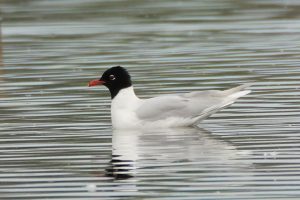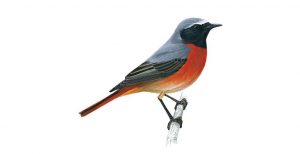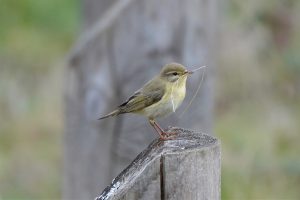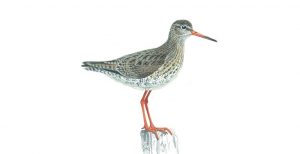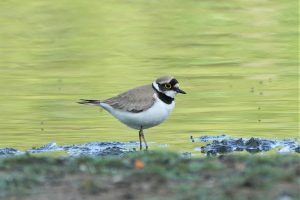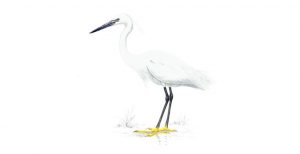In contrast to 2021, our 2022 Spring and early Summer weather was rather settled and drier, sunnier, and warmer than average. Persistent high pressure enabled a summer heatwave to build and by mid-July the reserve sizzled with record-breaking temperatures reaching almost 40°C on July 18th and 19th. Birding-wise it was an active few months with Spring migration followed by another productive breeding season and several records broken.
April-May
Fleet Pond’s Summer migrants and breeders arrived largely on schedule in April, including (2021 first arrival dates in parentheses) the first Reed Warbler on 13th (14th), Common Tern on 15th (16th), Garden Warblers on 24th (26th), Sedge Warbler on 25th (21st) and the first two (Common) Swifts of season on 27th. Whilst exiting winter migrants included a singing Brambling on April 7th-8th.
Hirundines were rather scarce throughout, but were supplemented by sporadic influxes of migrants. Spring high counts included 80 Swallows feeding over the Pond on April 27th, 30 Sand Martins on May 1st and 50 House Martins on May 25th while Swifts peaked at 70 on May 11th.
Scarcer migrants included a flurry of waders early on the morning on April 23rd, with a Ruff that circled the Pond unsuccessfully attempting to land on the central islands before leaving northwest. A Greenshank also left northwest that morning, while the first Common Sandpiper of spring was present, with others recorded on April 25th and May 18th.
A credible report was received of a flock of 15-20 Whimbrel circling the Pond early on May 2nd. The flock eventually left northeast, and two further singles were seen on May 4th, one heading over northeast and a second dropping into the central islands.
The only spring record of Oystercatcher was a single heading over northwest on May 16th. Notable migrant gulls and terns included two single Little Gulls briefly on April 22nd (single adult pictured below), a prelude to a flock of 16 (15 adults and a 2nd CY) that dropped in briefly on the evening of April 23rd. The latter represents the highest count of Little Gulls ever recorded in the northern half of the county.
At least four Mediterranean Gulls (3 adults and a 2nd CY) were encountered on and off in April and into early May, but sadly none stayed to breed although one of the adults appeared to be paired with a Black-headed Gull! (single adult Mediterranean Gull pictured below)
Terns were few with Common Tern the only species sighted. Lesser Black-backed and Herring Gulls were a regular sight, with a noteworthy record of 14 of the latter roosting on April 6th. Migrant wildfowl included several sightings of Common Shelduck, a single present on April 27th, two over southeast on April 28th and a flock of four on May 16th.
A singing male Common Redstart (illustrated above) encountered in woodland adjoining the East Marsh on April 23rd, was a rare spring sighting while the only Cuckoo of the spring moved through the reserve northbound on May 18th.
Notable raptors included a series of sightings of Peregrine Falcon in April and May, the first Hobby of spring on May 1st and a loose flock of 21 Red Kites heading over southwest on May 23rd. A Great White Egret observed at the Coldstream Marsh on April 9th was the first record of 2022.
June and the Breeding Season
It is turning out to be another good year for breeding wildfowl at Fleet Pond, particularly for Gadwall and Tufted Duck, a testament to the continued better water quality and the prevalence of horned pondweed. Tufted Duck took top honours with a record breaking 22 broods and 80-100 young hatched, with approximately 50 of these on course to survive, and represents the highest breeding density for the species in Hampshire at the moment.
Mallard and Gadwall logged 18 and eight broods respectively, the latter a Fleet Pond record, although survival rates were mixed for both. Three pairs of Common Pochard were present and two broods seen but sadly none of the young are thought to have survived while a pair of Shoveler was suspected of breeding unsuccessfully. Three pairs of Great Crested Grebes were in residence but as of the time of writing no young have yet been seen. A pair of Mute Swans are on course to raise five cygnets and at least three pairs Greylag Geese bred with the parents quickly leading their young to the Little Pond via the tunnels below the railway line, never to be seen again.
Other breeding successes included at least 100 pairs of Black-headed Gulls on the Central Islands, seven Grey Heron nests of which five raised at least 10 young, and a juvenile Water Rail seen at Sandy Bay on July 7th confirming successful breeding. Intriguingly, Little Egrets were present throughout the season with one individual prospecting a suspected nest site, but sadly nothing progressed.
Passerines included at least two Sedge Warblers and 20 Reed Warblers in territory within the Reserve’s reedbeds as well as a single Cetti’s Warbler territory. Garden Warbler territories numbered three while Whitethroats continue to do well with multiple territories at the MoD Fields as well as pairs at the Coldstream and Fugelmere Marshes. However, Blackcap, a common breeder within the Reserve, appeared to be in lower numbers than 2021 and no Firecrest territories found in the Brookly Wood this year, their favoured trees concerningly felled. On the positive side, a pair of Grey Wagtails bred at the Little Pond while a Willow Warbler was seen collecting nesting material at the Dry Heath in late April. (pictured below)
Subsequent sightings in June suggest breeding occurred at this site, the first such breeding of Willow Warbler at the reserve in more than a decade.
Post Breeding and Early Autumn Migrants
Late June heralds a change of seasons in the birding calendar, as early breeders begin their southbound migration and other species disperse widely from their breeding sites. Activity started early this summer with the first Teal noted on June 21st followed by a male Shoveler on July 3rd. Returning waders chipped-in with a series of sightings of Common Redshank; a single present on the evening of June 28th (illustrated below), a flock of three circling the central islands early on June 30th which left southwest and another flying over west on July 2nd.
A confiding adult Little Ringed Plover (pictured below) graced Sandy Bay on June 29th and 30th while the first Common Sandpipers of the Autumn (two) appeared on July 3rd and single Green Sandpipers on July 7th and 12th. A Great White Egret arriving from the east early on July 6th will hopefully be the first many over the coming months.
Little Egrets (illustrated below) continued to prosper with a high count of 11 roosting on the evening July 11th. A build-up of post-breeding Starling roosting in the Central Islands was noted again this summer with 100 noted on June 1st quickly expanding to over 800 by June 29th and 1,100 on July 1st.
With autumn migration now starting to build-up steam, the next few months will ensure there is plenty to find and see at Fleet Pond, so do remember to bring your binoculars. Good Birding!
William Legge
Contributing Observers: Abel Barker, Arun Bose, Ed Butler, John Clark, N Hayward, Cathy Holden, William Legge, Nikki Palmer, and Graham Stephenson.
Photograph credits: William Legge
Illustrations: RSPB www.rspb.org.uk/birds-and-wildlife/wildlife-guides/bird-a-z/


